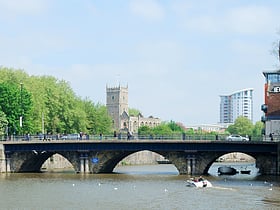Bristol: Thomas Paty
Places and attractions in the Thomas Paty category
Categories
- Church
- Park
- Museum
- Nightlife
- Georgian architecture
- Gothic Revival architecture
- Shopping
- Historical place
- History museum
- Street
- Vernacular architecture
- Concerts and shows
- Tower
- Memorial
- Bridge
- Neighbourhood
- Thomas Paty
- Harbor
- Shopping district
- Gothic architecture
- Area
- Art museum
- Shopping centre
- Theater
- Sacred and religious sites
- Specialty museum
- Music venue
- Art gallery
- Farm
- Ship
- Natural attraction
- Nature
- Archaeological site
- Sport
- Sport venue
- Canal
- Village
- Cinema
- Music and shows
St Nicholas
St Nicholas is a church in St Nicholas Street, Bristol, England. The church was bombed in the Second World War and rebuilt in 1974–1975 as a church museum. This museum closed in 2007 and the building was used by the city council as offices; in 2018 the church came back into use as an Anglican place of worship in the Diocese of Bristol.
Bristol Bridge
Bristol Bridge is a bridge over the floating harbour in Bristol, England. The floating harbour was constructed on the original course of the River Avon, and there has been a bridge on the site since long before the harbour was created by impounding the river in 1809.
Bristol Old Vic
Bristol Old Vic is a British theatre company based at the Theatre Royal, Bristol. The present company was established in 1946 as an offshoot of the Old Vic in London. It is associated with the Bristol Old Vic Theatre School, which became a financially independent organisation in the 1990s.
Redland Chapel
Redland Parish Church is a Georgian church, built in 1742, in the Redland suburb of Bristol, England. It is a Grade I listed building.
St Michael on the Mount Without
The Mount Without was a church now a creative space on St Michael's Hill in Bristol, England, near the University. It has been designated as a grade II* listed building, and was described as being in poor condition and on the Buildings at Risk Register.
Clifton Hill House
Clifton Hill House is a grade I listed Palladian villa in the Clifton area of Bristol, England. It was the first hall of residence for women in south-west England in 1909 due to the efforts of May Staveley.
The Exchange
The Exchange is a Grade I listed building built in 1741–43 by John Wood the Elder, on Corn Street, near the junction with Broad Street in Bristol, England. It was previously used as a corn and general trade exchange but is now used as offices and St Nicholas Market.
Map







